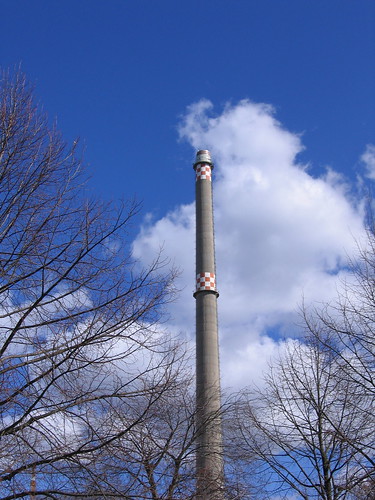Monday, December 28, 2009
Happy New Year
Friday, December 25, 2009
Four O'Clock Factoid: Canal Boats to Rapid Transit
Rochester, New York is home to an abandoned subway. Constructed in an abandoned segment of the Erie Canal, the line ran from 1927 until 1956. The route was grade separated for its entire length, but some interurban lines did connect from at-grade lines. In the downtown area, the canal was decked over with a new street, creating a subway. Trains ceased operating in 1956 when the eastern portion of the right-of-way was used to build an expressway.
Photo Friday: White Washed
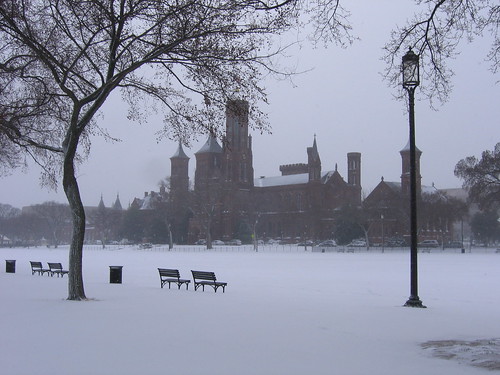
A blanket of snow covers the National Mall giving it an almost surreal feal
Thursday, December 24, 2009
Four O'Clock Factoid: Turbotrain
In an effort to improve passenger service in North America, the TurboTrain was introduced by Canadian National for runs between Toronto and Montreal in 1968. The train also began runs in the United States in 1968 on the New Haven Railroad. The train used gas turbine engines for propulsion and its lightweight, articulated design gave it a speed advantage over traditional trains in North America. The TurboTrain set the North American speed record for a production train at 170.8 miles per hour on December 20, 1968 on the Northeast Corridor between Trenton and New Brunswick.
Wednesday, December 23, 2009
Four O'Clock Factoid: Transit, Compromise, Renewal
When PATH took over the Hudson and Manhattan Railroad in 1962, it represented a compromise decades in the making. The construction of the World Trade Center proved too difficult a compromise for New York and New Jersey to agree on. Allowing the Port Authority to take over the Hudson and Manhattan to create a site for the World Trade Center at the H&M Terminal gave New Jersey an incentive to participate. And the creation of a major employment center rejuvenated ridership on PATH.
Wednesday Wrap: 12/23
Wednesday Weekly Wrap-Up is a feature looking back on transportation and planning news and opinions from the last week or so.
- Raise the Roof: CSX is speeding up plans for a National Gateway, which I talked about in September.
- More Trains, More Riders: Amtrak's new Lynchburg-Washington service, subsidized by Virginia, is beating ridership projections.
- Bypass the EIS on the NEC: So opines the Boston Globe, regarding the potential loss of stimulus money for improvements to the Northeast Corridor.
- Future, meet Past: Workers building Minneapolis-Saint Paul's Central Corridor light rail line recently unearthed a relic of transit from the early days.
- Recession Hurts Transit: APTA reports that rail ridership was down in the first 9 months of 2009, mainly due to unemployment.
Tuesday, December 22, 2009
Four O'Clock Factoid: 'Tear Down This Wall'
On December 22, 1989 the Brandenburg Gate reopened. For just under 3 decades, the famous landmark had been located within the death strip within the Berlin Wall. Today the gate continues to be a symbol of the city of Berlin and of German reunification.
Transit Tuesday: Elevated Underground
When Washington’s rapid transit system was being planned, regional leaders specifically shied away from calling it a subway, primarily because much of the network would not be below ground. Of course, even in cities where terms like “subway” and “elevated” are used, trains are not exclusively above or below ground.
The graphs below compare America’s heavy rail system based on their relationship to the ground: how much they’re on it, under it, or above it. The first chart shows the total system mileage in each category, while the second chart shows the percentage of the system in each category.


If any system deserves the moniker "subway" it's Los Angeles, where everything except for the rail yard is underground. New York's famous subway is only 56% underground. And Chicago's L (for 'elevated') has nothing on Miami, with its high water table. Miami has no underground sections, and only a few places where it runs at grade. Miami is 95% elevated, while Chicago's L is only elevated 54% of the time.
In addition to the aboveground/underground descriptors, all-capital acronyms caught on briefly. As did 'metros,' which can be found from Washington to Los Angeles and Miami to Baltimore, along with in places around the globe.
Monday, December 21, 2009
Meta Post: Regular Features
Four O'Clock Factoid: The People's Subway
The Moscow Metro is the world's second-busiest, carrying over 7 million passengers each weekday. Many of the stations are notable for their rich architectural design. This concept was rooted in Russia's socialist tradition, and indicates the designers' belief that this was to be a space for the people.
Snowpocalypse 2009
If you're planning on visiting Washington anytime soon, bring a shovel.
Monday Shot: Honeycomb
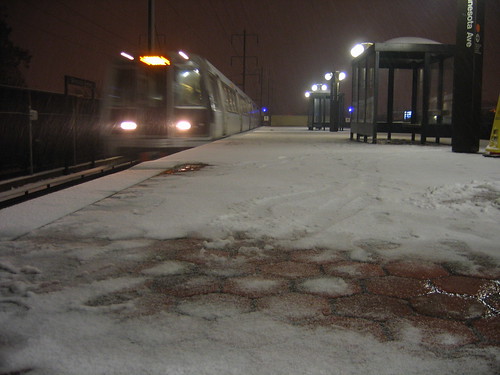
My photostream
Friday, December 18, 2009
Four O'Clock Factoid: Riding the Waves
The Florida Overseas Railroad was an extension of the Florida East Coast Railway to Key West. The line ran from 1912 to 1935. Upon completion in 1912, it was widely known as the "Eighth Wonder of the World." Much of the railroad was destroyed in a 1935 hurricane and the FEC sold the right-of-way to the state of Florida, which later used the infrastructure to build the "Overseas Highway" (US 1) to Key West.
Photo Friday: Rosslyn Sunset
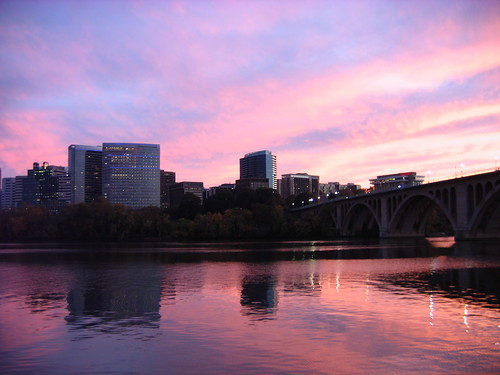
The Potomac is an excellent mirror for the November sky in the evening
Thursday, December 17, 2009
Four O'Clock Factoid: TGV
In 1981, France's SNCF began operating the TGV service between Paris and Lyon. Introduction of the TGV was the first modern high-speed rail service on the European continent. One innovation of the TGV was that trains shared tracks with other trains in city centers, but used their own exclusive tracks, known as LGVs, for the long-haul.
Wednesday, December 16, 2009
Four O'Clock Factoid: F for Fancy
F Units are a well-recognized line of diesel-electric railway engines produced by General Motors' Electro-Motive Division. These smoothly curving engines were very successful after their introduction in 1939 and played a major role in replacing steam power in North American railroading. While many associate their clean lines with crack passenger expresses, they were actually designed for freight service.
Wednesday Wrap: 12/15/09
Wednesday Weekly Wrap-Up is a feature looking back on transportation and planning news and opinions from the last week or so.
- A Sunset Every Day: At least one blog is reporting, with high confidence, that Amtrak is working to increase the frequency of the New Orleans-Los Angeles Sunset Limited to 7 days a week.
- Cheaper NEC Tickets?: New language in the DOT funding bill could mean cheaper Amtrak fares for commuter-oriented trains.
- Downeaster going Northeaster?: Maine is hoping to get word soon that it's received stimulus money to extend the Amtrak Downeaster, which currently runs from Boston North Station to Portland, on up to Brunwick.
- MoDot hopes for faster Trains: Like Maine, the Show Me state is hoping for stimulus funds to improve Amtrak service.
- Chalk another one up to Measure R: Los Angeles is now planning another light rail line, this one running from near LAX to the new Expo Line via Crenshaw.
- AirBART not up-in-the-air: Looks like a BART-OAK connector is in the works after all. The guideway will link the Coliseum BART stop with Oakland Airport in 14 minutes at an estimated cost of $12. BART recently awarded the contract for the project.
Tuesday, December 15, 2009
Four O'Clock Factoid: Olympiapark
Munich's Olympiapark is a lasting reminder of the 1972 Olympic Games. The area converted a former airfield into a vast district home to a variety of venues, a village, and parkland. Today, the site is still a major recreational and cultural center. It is in stark contrast to some cities, like Atlanta, where little is left in the urban form as a legacy from the games.
Peachtree Proliferation
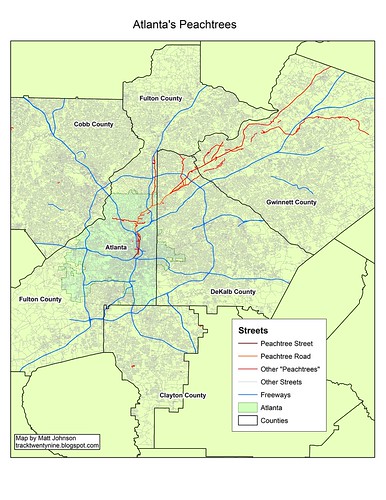
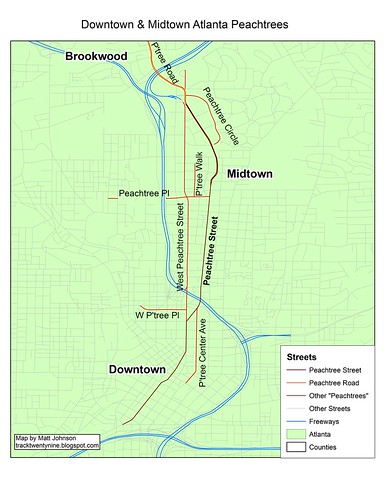

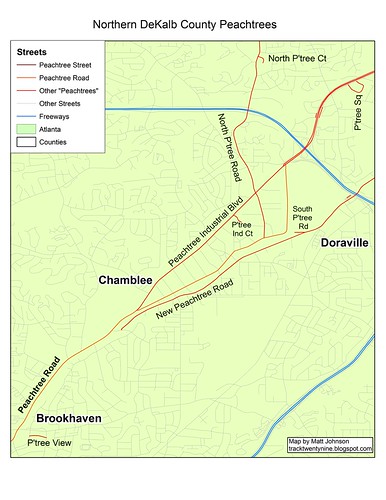
Of the five core counties in the Metro area, Cobb County has the fewest Peachtrees, with just three. Cobb’s Peachtree streets include:
- Peachtree Circle
- Standing Peachtree Court
- Standing Peachtree Trail
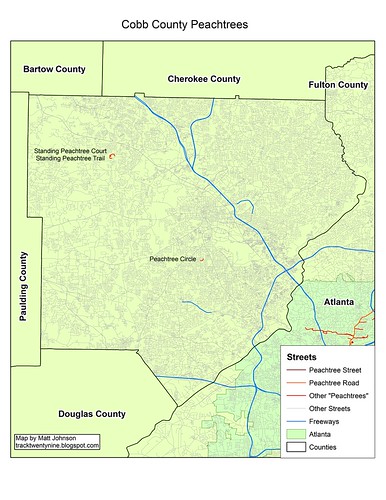
- Peachtree Drive
- Peachtree Court
- Peachtree Farms Road
- Peachtree Lane
- Peachtree Way
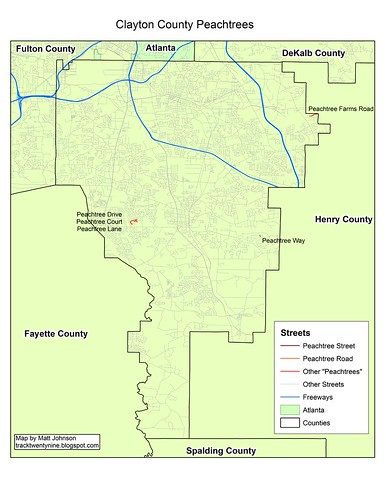
- North Peachtree Court
- North Peachtree Road
- North Peachtree Way
- New Peachtree Road
- Peachtree Boulevard
- Peachtree Industrial Boulevard - continues into Gwinnett County
- Peachtree Industrial Court
- Peachtree North Court
- Peachtree Place Parkway
- Peachtree Road - continues into the City of Atlanta
- Peachtree Square
- Peachtree View
- South Peachtree Road
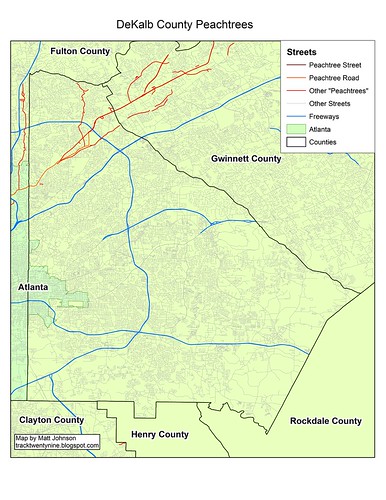
- Peachtree Dunwoody Circle
- Peachtree Dunwoody Court
- Peachtree Dunwoody Road - continues into the City of Atlanta
- Peachtree Hollow Court
- Peachtree Avenue
- Peachtree Battle Avenue
- Peachtree Battle Circle
- Peachtree Battle Place
- Peachtree Center Avenue
- Peachtree Circle
- Peachtree Drive
- Peachtree Dunwoody Road - continues into Fulton County
- Peachtree Hills Avenue
- Peachtree Hills Circle
- Peachtree Memorial Drive
- Peachtree Park Drive
- Peachtree Place
- Peachtree Road - continues into DeKalb County
- Peachtree Street
- Peachtree Valley Road
- Peachtree Walk
- Peachtree Way
- Spring West Peachtree Connector
- West Peachtree Place
- West Peachtree Street

- North Peachtree Street
- Old Peachtree Road
- Peachtree Bluff Court
- Peachtree Chase
- Peachtree Circle
- Peachtree Corners Circle
- Peachtree Corners East
- Peachtree Crest Drive
- Peachtree Forest Avenue
- Peachtree Forest Drive
- Peachtree Forest Terrace
- Peachtree Industrial Boulevard - continues into DeKalb County
- Peachtree Lakes Drive
- Peachtree Parc Court
- Peachtree Parc Lane
- Peachtree Parkway
- Peachtree Place
- Peachtree Road
- Peachtree Ridge Court
- Peachtree Ridge Drive
- Peachtree Street
- Peachtree Walk
- South Old Peachtree Road
- South Peachtree Street
- West Peachtree Street

Transit Tuesday: Commuter Rail "Balance"
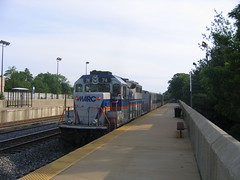 Transit Tuesday is a weekly feature or profile on transit.
Transit Tuesday is a weekly feature or profile on transit.I wrote recently about the “Rail Transit Continuum.” In that post I made a distinction between commuter rail and regional rail, using service characteristics to draw the line. Commuter rail lines, I said, are primarily oriented toward getting suburbanites into the city center for work. Regional Rail, on the other hand, acts more like a metro system, with more frequent trains running in both directions.
This week, Transit Tuesday takes a look at the “balance” America’s commuter rail operators. Some operators are very imbalanced, with most or all trains running only inbound during the morning. Other systems have a better balance of inbound and outbound trains during the morning and evening peaks.

Click for a larger image
Graphic Notes:
In the above graphic, inbound trips are shown in blue, outbound in red. The bars represent the total number of arrivals or departures at the primary terminal(s) of the network. The “balance” can be seen as how close each agency’s inbound and outbound bars are to each other. The graphic only shows trains arriving or departing at the central city terminal between their opening and 9:30 AM (inclusive).
For systems with more than one major city, the largest city is considered to be the destination of inbound trips. So in the Washington-Baltimore region, for instance, MARC trains are "inbound" toward Washington. The city used as the inbound destination is shown along the graphic’s y-axis, to the left of the dash.
In the case of New York, inbound trains on NJ Transit’s commuter rail lines end at one of four locations, NYC Penn Station, Hoboken, or Newark Penn Station in the New York area, and 30th Street - Philadelphia for the Atlantic City Line. For the totaling, any inbound trip terminating at one of those four stations is considered as an inbound trip. The same can be said for outbound, departing trips.
Trains that continue through the central city terminal, as is the case with SEPTA Regional Rail trains, are counted as both an inbound and outbound trip. However, trains which pass through the center city terminal, but do not continue to the suburbs are only considered an inbound trip.
Discussion:
Of the 22 commuter rail operators in the United States, only one has no reverse-commute trains. That service is the Altamont Commuter Express, which operates from Stockton to San Jose in California. The other systems all have at least one, though not on all the lines they operate.
Some commuter/regional rail operators would be expected to have good parity between peak-direction and reverse-commute trains based on the structure of their regions. South Florida’s Tri-Rail and Dallas-Fort Worth’s TRE both operate between major cities, so significant amounts of commuting in the opposite direction from the peak is predictable. But other cities with more monocentric downtowns sometimes have reverse-commute service on par with their peak-direction service. Examples include Nashville and Albuquerque.
Three systems actually have more outbound than inbound trains in the AM peak. This is probably an artifact of railyard location or some other operating constraint. However, Caltrain, FrontRunner, and Tri-Rail each have at least 2 more reverse-commute trains than peak-direction trains.
Another three systems have perfect parity, with the same number of inbound arrivals and outbound departures. These include Portland’s WES, Nashville’s Music City Star, and Dallas’ TRE.
Other than San Jose’s ACE, the worst ratio of outbound to inbound trains is VRE’s, which has 1 morning outbound train (on the Manassas Line) and 12 inbound trains (total). Seattle’s 2 outbound trains to 11 inbound trains is also a ratio that has room for improvement.
Monday, December 14, 2009
Four O'Clock Factoid: Air Pressure
The Peachtree Center Station on Atlanta's MARTA system is 120 feet deep. It was carved from solid gneiss. Due to the geology, pressurized air was required to keep the station from collapsing during construction. Workers had to undergo 30 minutes of compression/decompression when entering/leaving the site. It opened September 11, 1982.
Monday Shot: Ride the Rocket

My photostream
Friday, December 11, 2009
Four O'Clock Factoid: Donner Summit
The Summit Tunnel near the top of the Donner Pass along with the railroad approaches to it constituted the most difficult engineering feat in the construction of the Central Pacific Railroad. Completed in 1868, it was in continuous use until 1993, when Southern Pacific abandoned the route in favor of the newer, lower Tunnel #41.
Photo Friday: Boats on the Water
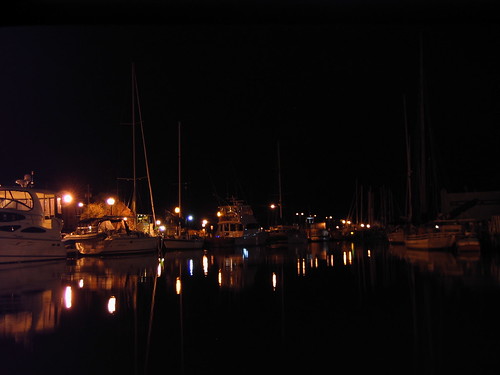
Boats moored in Annapolis' harbor offer an interesting light show at night.
Thursday, December 10, 2009
Four O'Clock Factoid: Luxury and Intrigue
The Orient Express is perhaps one of the best-known trains in the world. Since its debut in 1883 as a train running between Paris and Istanbul, several different routes, origins, and destinations have been used with the brand. Today's Orient Express operates between Strasbourg and Vienna.
Arlington's Systemic Streets
While Arlington was originally part of the District of Columbia (until 1846), it was not incorporated in the plan of Pierre L'Enfant. Unlike its larger neighbor, Arlington's streets don't follow a strict grid, but development has still followed a somewhat rectilinear pattern. The street-naming system dates back to 1932, and was undertaken in order to convince the Postal Service to allow "Arlington" as the mailing address for the entire county.
The county is divided into northern and southern sections by Arlington Boulevard, a major east-west thoroughfare which bisects the county.
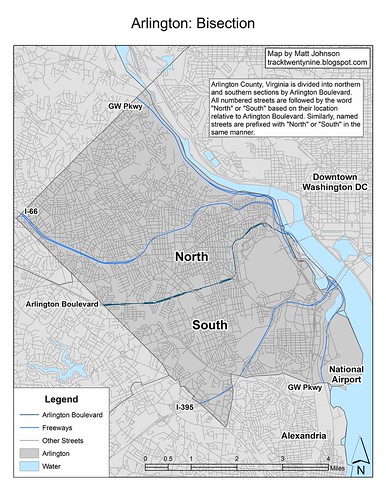

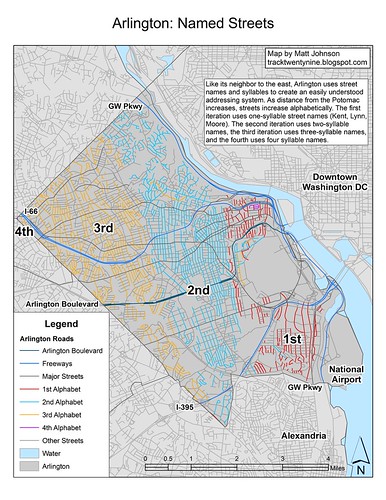
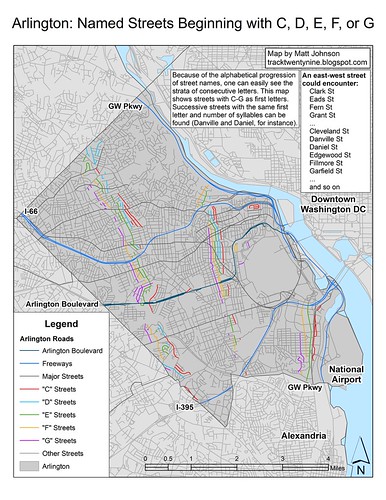
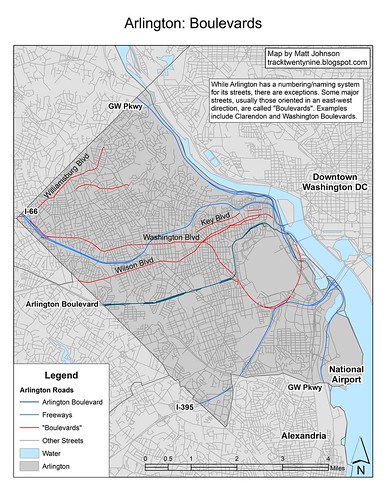
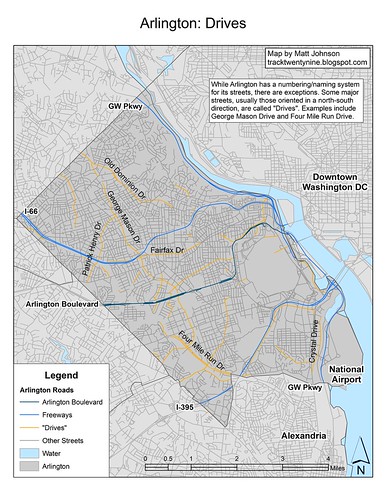
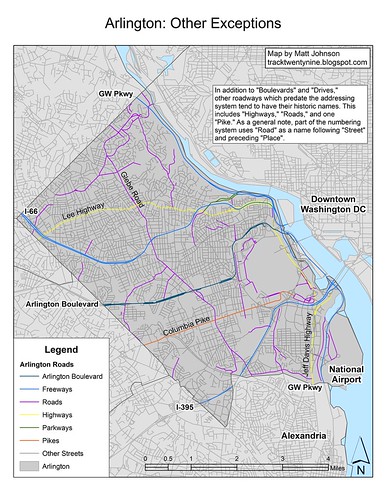
Wednesday, December 9, 2009
Four O'Clock Factoid: 126 MPH
The Mallard was a LNER Class A4 locomotive which set the world speed record for a steam locomotive at 126 miles per hour on July 3, 1938. Mallard operated on the London and Northeastern Railway until April 1963. It was 5 months old when it set the record.
Wednesday Wrap: 12/9/09
- Newsbreak: Better bus service increases ridership: One wonders why we don't do more of this. Everett's new Swift BRT will likely increase transit ridership. Hopefully we'll see more arterial bus improvements around the nation.
- Light Rail for Florida: Pinellas County Florida has officially added light rail to long-term plans. By 2033 a line could be operating between Saint Pete and Clearwater.
- Rain Good for Streetcars: There must be something in the rain. Another Pacific Northwestern city, Spokane, is looking at Streetcars. If Portland is any indication, they can't go wrong.
- Lay down the Trails and tear up the Tracks: Work is finally starting on Atlanta's Beltline corridor. The first step is removing the old tracks. So far the oldest rail that's been found dates to 1904.
- SunRail moving forward: Florida's House of Representatives passed a commuter rail bill in special session this week. And the Senate followed suit. Governor Crist has promised to sign the legislation. The bill would help maintain Miami's Tri-Rail and would set up commuter rail in central Florida.
- Come on ride the Train: Amtrak saw record ridership over Thanksgiving.
- LaHood takes on Coburn: Secretary of Transportation, Ray LaHood recently wrote a post on the DOT's blog challenging Oklahoma Senator Coburn's worldview. Well, at least his view of alternative transportation.
Tuesday, December 8, 2009
Four O'Clock Factoid: AICP
The American Institute of Certified Planners is the professional organization for planners in the United States. Like other professional organizations, the AICP and it's parent organization, the American Planning Association, assists members with continuing education, professional development, and the standards of the practice.
Transit Tuesday: Bikes on Board
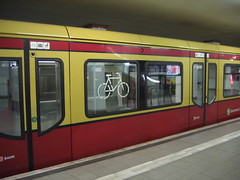 Transit Tuesday is a weekly feature or profile on transit.
Transit Tuesday is a weekly feature or profile on transit.Bikes and transit often seem to be a match made in heaven. When the bus is too infrequent or the walk just a bit too far, a bicycle can get a transit rider to a multitude of destinations. As a result of the increasing popularity of cycling and transit, many agencies are taking steps to include bikers. Today, Transit Tuesday looks at allowing bikes onboard railcars.
Lockouts
Heavy Rail
Six heavy rail systems have a bike “lockout” period during each rush hour because trains and stations are crowded. During these periods, cyclists must leave their bike at the station or ride to their destination. Systems with lockouts are: Boston T, Chicago L, Los Angeles Metro, PATH, Philadelphia (Broad Street & Market-Frankford), and Washington Metro. New York’s MTA has a lockout for bikes on the Staten Island Railway, but not the other subway services.
In contrast, San Francisco’s BART prohibits bikes on certain trains on specific parts of each line during rush hours, instead of a blanket lockout. This allows cyclists to use less-crowded trains operating in the off-peak direction or on inbound trains which are not yet crowded.
Other cities don’t have prohibitions on bikes during rush hours: Baltimore Metro, Cleveland Rapid, MARTA, Miami Metro, New York Subway, and the PATCO Speedline. However, Miami requires bikers to have a permit at all times of the day.
Boston prohibits cyclists from using the downtown transfer stations except to change lines. Cyclists may not enter or exit those stations at any time.
Light Rail
Among light rail systems, Boston’s Green and Mattapan Lines, Philadelphia’s light rail lines, and San Francisco’s Muni Metro are unique in barring bicycles at all times.
Houston, Hudson-Bergen, Newark, and Pittsburgh have rush hour bike prohibitions. Los Angeles bans bikes during rush hours on light rail trains in the peak direction only.
Commuter Rail
Two commuter rail systems have a blanket ban on cycles at all times: Maryland’s MARC and Chicago/Indiana’s South Shore Line.
SEPTA Regional Rail trains have a ban on bikes during rush hours.
Five systems ban bikes on peak direction trains during rush hours only. Those systems are: MBTA Commuter Rail, Chicago’s Metra, NJ Transit Commuter Rail, and New York’s Long Island and Metro North Railroads.
Virginia Railway Express bans bikes from certain trains, but it is possible to bring your bike on board some rush hour, peak direction trains.
The remaining 13 systems allow bikers on board at all times. They are: New Mexico Rail Runner, Trinity Railway Express, Los Angeles’ Metrolink, Miami’s Tri-Rail, Minneapolis’ Northstar, Nashville’s Music City Star, Connecticut’s Shore Line East, the FrontRunner in Salt Lake City, California’s Caltrain, Coaster, and ACE, Seattle’s Sounder, and Portland’s WES.
Permits are required in order for bikers to bring their cycles onboard Metro North and the Long Island Railroad. Cyclists can only board NJ Transit commuter trains at “accessible” stations (where the doors in the center of the coach open).
Car Capacity
Heavy Rail
Boston, Chicago, Cleveland, PATH, and Washington impose a limit of 2 bikes per car on weekdays. Miami allows up to 4 bikes per car, but bikes are only allowed in the last car of the train. PATH and BART do not allow cycles in the first car of the train. Other operators don’t specifically mention a limit on cycles per car, but all require that bikers avoid crowded trains.
Light Rail
San Diego’s Trolley has a limit of 1 bike per car during rush hours, 2 bikes per car otherwise. Buffalo, Cleveland’s light rail, and Houston have a limit of 2 bikes per car. Denver, Sacramento, Salt Lake City, Seattle, and Tacoma allow a maximum of 4 bikes per car. San Jose’s VTA allows 6 bikes per car, although they must remain in the center articulation area. Other cities don’t have specific limits on the number of bikes, although some mandate that cycles remain in certain areas of the car, which presents an inherent limit.
In Sacramento, the last train of the day in each direction has no bike limit.
Many light rail systems, because of handicap access and the high-floor nature of the cars have restrictions on which areas of the car can be used for bikes. Baltimore, Denver, Sacramento, and St. Louis disallow bikes from using the first door on the train, but Buffalo requires cycles to use the first door.
Pittsburgh’s LRT is a mix of high-platform “stations” and low-platform “stops.” Bikes can only board and alight at high-platform stations.
Commuter Rail
America’s newest commuter rail line, Minneapolis’ Northstar allows for one bike per car. Rail Runner, Metra, Metrolink, Tri Rail, and NJ Transit have maximums of around 2 bikes per car. Coaster and Sounder allow for up to 4 bikes per car. WES allows for 6 in each car.
Metro North and the Long Island Railroad have a limit of 4 bikes per train and require that bikes be in the first or last car, with a limit of two in each. SEPTA and VRE allow for only 2 bikes per train. In VRE’s case, cycles are required to be in the cab car.
The Bay Area seems to come out on top in regards to bike access to commuter rail. ACE allows for 34 bikes per train. And Caltrain, which claims to have the premiere bike-on-transit program, runs all trains with at least one “bike car.” This allows for a minimum of 40-48 bikes per train. Some trains have two bike cars, which doubles bike capacity.
Other systems don’t include maximum limits per car, but several require that bikes fit in the area reserved for ADA access, including the Music City Star and Trinity Railway Express. Even systems with maximums often require bikers to vacate space for disabled passengers, even to the point of leaving the train before their journey is finished. Few systems guarantee space for cycles, but more are moving in that direction. The Utah Transit Authority recently announced that they’re looking for ways to increase the amount of space for bikers on FrontRunner.
Monday, December 7, 2009
Four O'Clock Factoid: Speeding
1994's Speed featured several parts of the LA area's transit system. Much of the film takes place on a bus, ostensibly a Santa Monica Big Blue Bus. During the early parts of the film, the bus uses the I-105 freeway, which was nearing completion at the time. In the background of many shots, one can see the tracks of LA's Green Line, also under construction at the time. Later in the film, LA's Metro plays a prominent role, eventually crashing through the construction at the end of the line to wind up on Hollywood Boulevard.
Meet Me Tomorrow
Monday Shot: Oberbaum

My photostream
Friday, December 4, 2009
Four O'Clock Factoid: Rack 'em and Stack 'em
New York County, synonymous with the borough Manhattan, is the most densely populated county in the United States. In 2008, the average density of Manhattan was 71,201 persons per square mile. However, Manhattan is not the most populous of New York City's five boroughs. That distinction goes to Brooklyn.
Photo Friday: Alberta Bound
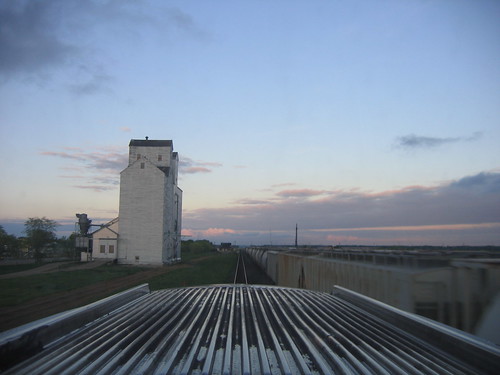
I captured this shot of a dusky sky from the observation dome of the rear car of Via's Canadian.
My Photostream
Thursday, December 3, 2009
Four O'Clock Factoid: Rollin' Down the Seaboard Line
In 1965, Johhny Cash popularized the song Orange Blossom Special, a song named after the famed train of the same name. The Orange Blossom ran from New York Penn Station to Miami or St. Petersburg, Florida. The train operated from 1925-1953 over the Pennsylvania Railroad, the RF&P, and the Seaboard Airline Railroad.
Hey talk about a-ramblin'
She's the fastest train on the line.
Talk about a-travelin'
She's the fastest train on the line.
It's that Orange Blossom Special
Rollin' down the Seaboard line.
Wednesday, December 2, 2009
Four O'Clock Factoid: It's Electric!
The Black Mesa and Lake Powell Railroad is a private freight railroad operating in Arizona. It is noteworthy as an American railroad in that it is electrified. The line is used to carry coal from mines on the Black Mesa to a power plant near Lake Powell. It was constructed in the 1970s and is completely disconnected from the rest of the American rail network.
Here's a video from e44e33 on YouTube.
Wednesday Wrap: 12/2
- The Fast Bus: Washington state has its first BRT line. The "Swift" runs 17 miles from Everett to Shoreline and has stops about every 2 miles.
- A Streetcar Named 'Big D': Dallas is trying for several million dollars of federal funding for two new trolley routes to complement the successful DART light rail.
- Wave of the Future?: NPR considers the future of Personal Rapid Transit.
- Travel Week: This week is busy for all modes of transportation, and Amtrak is no exception. Two additional trains were added to the route of the Cascades in Washington and Oregon. Other trains ran full.
- A Troubled Bridge over Water: The New York Post reports that after years of underfunding, many of Amtrak's rail bridges in New York are in bad repair.
- Closer to South Coast Trains: Massachusetts and CSX are getting closer to an agreement to return passenger trains to the South Coast, perhaps by 2010.
- Sunshine State Looks at Rail: It looks likely that Florida's Legislature will hold a special session to consider commuter and high-speed rail.
- Save the Stations: The Detroit Free Press looks at how two cities managed to resurrect their rundown train stations. Can Detroit follow suit?
- OKC Without a Car: The mayor of Oklahoma City would like to see a city where you don't need a car to get around. And he's pushing a streetcar as one way to do that.
- Aloha Delays: Hawaii has decided to review the Honolulu LRT's EIS. This could delay the project, which was set to break ground in January or February.
Tuesday, December 1, 2009
Four O'Clock Factoid: Steely Resolve
Atlantic Station is a new master plan community in Atlanta. The brownfield redevelopment site was home to Atlantic Steel for many years, but the new quarter has breathed life into Atlanta's urban fabric. Despite ample amounts of parking, the urban form keeps pedestrians on the streets. And since its 2005 opening, new urbanism is all the rage in the city often known as a poster-child of sprawl.
Transit Tuesday: Last Train Out
One thing that Washingtonians know is that it's often easier to take Metro. And for the most part, I think they're right. However, Metroing around has its limitations--especially after dark. The system is one of the first heavy rail systems in the United States to close every evening, and it is the first to start closing (unless you count CTA's Skokie Station).
Of course, WMATA is a chronically underfunded agency with many unmet needs. Still, it would seem on the surface to be essential for the subway to stay open late in Our Nation's Captial. While it is true that Washington has long held the distinction of being known as an early-to-bed, early-to-rise sort of town, they don't exactly roll up the sidewalks at 11:30. They do start rolling up the Metro, though. They start shutting it down at 11:24 every evening Sunday through Thursday.

Graphic Notes:
Opening: refers to the period between the earliest scheduled departure until all stations are open in all directions of travel.
Open: refers to the period when the entire system is in revenue service.
Closing: refers to the period between the last revenue departure at a station (in any direction) and the final revenue offload of the evening.
Example: WMATA is opening from 4:54, when the first Blue Line train leaves Largo, until 6:04, when the first train to leave Franconia arrives at Largo. WMATA starts closing at 11:24P, when the last train of the evening leaves Branch Avenue and is closed at 12:40, when the last train of the evening terminates at Shady Grove.

The point is that if Metro really wanted to extend service, it would be possible. Systems just as lengthy and of a similar era make do with less time for repairs. In some cases, notably Chicago and New York, places where the subway doesn't sleep, the maintenance issues are far more pronounced than Metro's. Chicago has more slow zones than you can count on all your fingers and New York's system faces the same sorts of problems that all centenarians face.
The maintenance issue is a non sequitur. Even if the maintenance that needed to be done was on a crossover, trains could still operate at 20 minute headways, which is just about right for late evenings. When switch work several weeks ago disrupted Green and Yellow service at Mount Vernon Square, trains operated every 20 minutes through two interlocking segments. Besides, Metro already does maintenance at night, often well before service ceases, but after passenger volumes have fallen off.
With high gas prices strangling the economy and a resurgence of interest in urban living, it is time for Metro to make significant improvements to its service. Later service is one step that can be taken. Even adding 30 minutes of service would be a considerable achievement for this, America's finest of subways.
What are your thoughts?
Monday, November 30, 2009
Four O'Clock Factoid: A Boat You Can Get On
San Juan's Tren Urbano is the first rapid transit system in the Carribbean. Opening in December 2004, the line runs 10.7 miles to the south and west from old San Juan and has 16 stations. Trains come every 4 minutes, and Puerto Rico's Tren Urbano has an average daily ridership of 38,700.
Monday Shot: Blue Blur
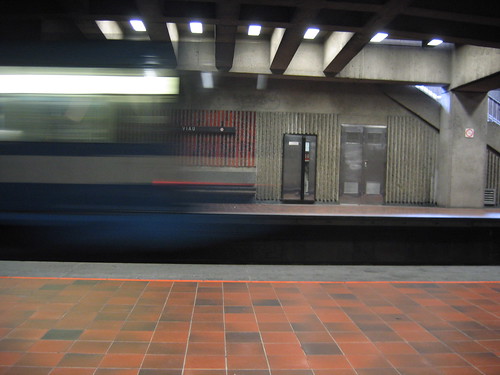
My photostream
Friday, November 27, 2009
Four O'Clock Factoid: Cantilevered
The longest cantilever span in the world spans the Saint Lawrence River near Charny, Quebec and is known as the Quebec Bridge. It is the most downstream crossing of the Saint Lawrence River and is owned by Canadian National Railway. It carries three lanes of auto traffic in addition to a pedestrian walkway. Via Rail Canada's Corridor trains traverse the bridge en route to Quebec City's Gare du Palais.
Metro brightens mezzanine at Judiciary Sq
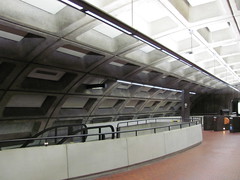 On November 24, Metro announced that they were testing new lighting at Judiciary Square's F Street Entrance. These new lights are designed to brighten the mezzanine, which has long been very dim. If the test is successful, the format will likely be expanded to other stations.
On November 24, Metro announced that they were testing new lighting at Judiciary Square's F Street Entrance. These new lights are designed to brighten the mezzanine, which has long been very dim. If the test is successful, the format will likely be expanded to other stations.Metro's original brutalist vaults were intended by their designer, Harry Weese, to be blank and to be lit entirely by indirect lighting. However, over the years, accoutrement has been added to the vaults, from station signs to security cameras. In most stations, supplemental lighting was added in mezzanines, which tend to be in perpetual shadow.
Fourth Street Entrance
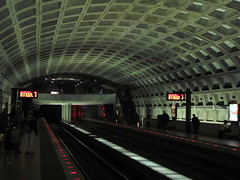
F Street Entrance
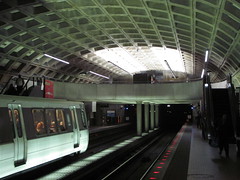
The new test lighting strikes a medium between the extremes. It adds lots of light to the mezzanines, while still providing light to the vault. At the same time, the fixtures' design limits the encroachment of the light supports on the vault.
All pictures in this post were taken by the author
Comments have been disabled. Please comment on this same post at Greater Greater Washington.
Photo Friday: Smokestack
Thursday, November 26, 2009
Four O'Clock Factoid: Disappearing Railroad Blues
Happy Thanksgiving!
Shortly after Amtrak began operations in 1971, the famous Illinois Central train The City of New Orleans was cancelled in favor of the overnight Panama Limited, which ran the same route. A 1972 song performed by Arlo Guthrie, The City of New Orleans, lamenting the disappearance of America's railroad heritage increased the popularity of the former Chicago-New Orleans train name, and in 1974, Amtrak restored the name "The City of New Orleans."
All the towns and people seem to fade into a bad dream,
and the steel rail still ain't heard the news.
The conductor sings his songs again, the passengers will please refrain.
This train's got the disappearing railroad blues.
Good night America, how are ya?
Say, don'tcha know me? I'm your native son!
I'm the train they call the City of New Orleans.
I'll be gone 500 miles when the day is done.
Wednesday, November 25, 2009
Four O'Clock Factoid: No Turns
The world's longest stretch of straight railroad track crosses Australia's Nullarbor plain. Across the flat desert, the track travels for just over 297 miles without so much as the slightest curve. It is traversed by the transcontinental train the Indian Pacific, which runs from Sydney to Perth and back twice a week.
Wednesday Wrap: 11/25
Happy Thanksgiving! Turkey day is tomorrow. In just a few hours, it'll be time for turkey and dressing, family and football. So stop reading this blog, and go help you mother with prep for the biggest meal of the year.
- The Armory Car: Newsweek looks at some of the implications of the legislative battle over guns on Amtrak. Republicans hope to force Amtrak to allow passengers to bring guns on board. Amtrak insists that this is a bad idea.
- The Orange Blossom Special Session: "She's the fastest train on the line" sings Johnny Cash. And it looks like Florida might just have a special legislative session to fund high-speed rail in the Sunshine State.
- Let's Cut Some Ribbons: An op-ed in The Hill encourages Washington to rethink infrastructure. We need to create jobs, and infrastructure is one way to do that, but we need to restrategize, say the writers.
- Windy City Express: South Bend fears it will get bypassed by Mid-West high-speed rail plans. They're calling for a solution that makes everyone happy.
- The Green Coast: A new study shows the savings from NJT's Hudson-Bergen light rail line. Maybe the "Gold Coast" should be renamed.
Tuesday, November 24, 2009
Four O'Clock Factoid: Master Builder
One of the most influential shapers of the urban form during the middle of the twentieth century was Robert Moses. His influence led to the construction of freeways across New York state and also helped lead to the demise of several transit lines in New York City. Many of the projects he championed are still integral parts of our transportation infrastructure, including the Triborough Bridge. In challenge to his critics, he charged: "if the ends don't justify the means, what does?"
Transit Tuesday: Airport Intermodal
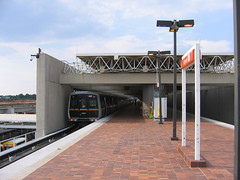
Thanksgiving is one of the busiest travel times of the year. Many people will be taking transit to the airport this week, so let’s take a look at airport-transit intermodal stations.
In 1968, Cleveland was the first American city to open a subway station directly inside an airport terminal. Passengers could board a Red Line train at Hopkins and ride downtown with one seat. Since then, many cities’ rail systems have been extended to the airport.
Cities with transit stations directly inside or adjacent to airport terminals are:
• Cleveland – Hopkins Airport, Red Line, 1968
• Washington – National Airport, Metro, 1977
• Atlanta – Hartsfield-Jackson Airport, MARTA, 1988
• Los Angeles – Bob Hope Airport, Metrolink/Amtrak, 1992
• Minneapolis – MSP Airport, Hiawatha Line, 2004
• Seattle – SeaTac Airport, Link, 2009 (UC)
• Providence – TF Green Airport, MBTA Commuter Rail, 2010 (UC)
Other cities have brought people mover systems from airports out to transit. Newark extended their airport people mover to a new station on the Northeast Corridor in 2001, where passengers can transfer to Amtrak and NJT Commuter Rail. Several cities have people mover connections between transit and airports in planning, including Dallas' Love Field and Phoenix's Sky Harbor Airport.
• Newark – Liberty Airport, AirTrain, 2001
Monday, November 23, 2009
Four O'Clock Factoid: Now That's Flying
The Shanghai Maglev Train is the world's first commerical application of a high-speed maglev line. Connecting Pudong International Airport to Metro Line 2, the train takes only 7 minutes 20 seconds to travel 30 kilometers (18.6mi). It travels at a top speed of 268 miles per hour briefly, and during testing reached a speed of 311 mph. An extension through southern Shanghai to Hongqiao Airport is in planning.
Monday Shot: Florida Sky
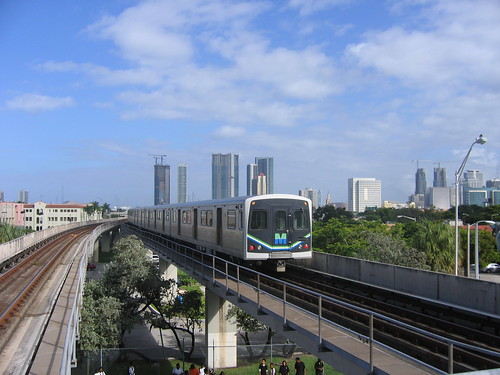
My photostream
Friday, November 20, 2009
Four O'Clock Factoid: Riding on One Rail
The Seattle Center Monorail connects downtown Seattle with the Seattle Center, home to the Space Needle. The line has one station at each end of the line: Westlake in the south and Seattle Center in the north. Over the years, various proposals to extend the line have been put forward. So far, none have come to fruition. The system was given landmark status in 2003.
Photo Friday: Parkway Lights
Thursday, November 19, 2009
Four O'Clock Factoid: Silver Streak
The wreck of the Federal Express, occurring on January 15, 1953 served as the inspiration for the 1976 movie Silver Streak. That day, the southbound Federal Express overshot the end of Track 16 at Washington's Union Station, crashed through the station master's office, and collapsed into the baggage room below the concourse (today's food court). The accident was caused when a design flaw on a New Haven Railroad car in the train's consist cut braking power to all cars except the locomotive.
Wednesday, November 18, 2009
Four O'Clock Factoid: The Big Hill
The Spiral Tunnels are a feat of engineering in the Canadian Rockies. Constructed from 1906-1909, they became an integral part of the Canadian transcontinental railroad. The tunnels allowed the CP Railway's grade to be reduced from an untenable and unsafe 4.5% to 2.2%. Trains still run through the tunnels, including the Kicking Horse route of the Rocky Mountaineer, so it's possible for passengers to ride through the tunnels (as I have done).
Wednesday Wrap: 'Complicit in your own Oppression'
- Reprogramming freeways: A New York Times op-ed looks at ways we can reuse freeways once driving on them isn't as big a deal.
- Bringing back the train: Jacksonville, Florida is seeking stimulus funding to get a transportation hub started. The second phase would bring passenger trains back to the old train station, which has since been converted to a convention center. It would be a big plus for riders, since the Skyway connects to the convention center and downtown.
- Transit co-operation: BART, which shares rail stations with Muni in downtown San Francisco is now releasing real-time info for Muni trains on its website.
- One-armed fare machines: Reno, Nevada is looking at constructing a streetcar line (later to be converted to LRT). The $67 million project would link downtown to the University of Reno campus. A second phase is also under consideration.
- Turbotrain Redux: Some 86% of Canadians support high speed rail and think all levels of government should be involved in getting it done.
- The Governator's Priority: California governor, Arnold Schwarzenegger, ordered state officials to drop all requests for rail stimulus funding except for the request for the California High Speed Rail program. Some are calling foul.
- Locos in the HOV Lane?: An Illinois company is leading the field in producing low-emission switcher locomotives. Since yards are often in urban areas and usually have the oldest engines in a railroad's fleet, significant health benefits could be realized.
- TSA Protecting Amcans: The TSA is now deploying personnel with bomb detection devices aboard Amtrak trains around the nation. Just as long as they don't have snow globe detectors, right?
- A Nice Paint Job: Minnesota's first commuter rail line, the Northstar, opened on Monday, and carried 2,400 riders. The trains have a very colorful paint scheme.
- Please Step Back to Allow Big Brother to Watch: The Obama Administration is planning to introduce new transit oversight legislation to Congress. Let's hope it doesn't kill transit off in the process.
- Splitting the Switch: Seattle's Link LRT is facing some criticism this morning after an out-of-service train split a switch at a rail yard disrupting service
yesterdayMonday. It's important to note that the train did not "derail", in fact, photos show that all the trucks stayed on the rails. But the final truck of the train did not diverge. This can still be an issue. The 1982 Washington Metro crash that killed three near Smithsonian was caused by splitting the switch. - Veronica Moss Returns: Hillarious A.U.T.O. lobbyist visits the newly reprogrammed Times Square, telling motorists that they should take the space back: 'you're complicit in your own oppression!'
What's the Most Crowded Part of Metro?
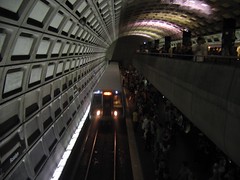 With an updated model of rider flows thanks to better data from WMATA, we can better understand crowding on Metrorail. Last week, We Love DC analyzed Metro crowding. They argued that Red Line riders have it worst because the Red Line carries 48% more riders than the Orange Line. However, the overall number of riders on the line as a whole is not enough to accurately measure congestion.
With an updated model of rider flows thanks to better data from WMATA, we can better understand crowding on Metrorail. Last week, We Love DC analyzed Metro crowding. They argued that Red Line riders have it worst because the Red Line carries 48% more riders than the Orange Line. However, the overall number of riders on the line as a whole is not enough to accurately measure congestion.The proportion of commuters in each direction matters as well. For instance, if we have two equivalent lines, each with the same ridership, and 90% of Line A's AM peak trips are inbound while only 60% of Line B's are, Line A will be more congested. It would still be more congested even if Line B had 10% more riders.
Another factor that must be considered is the spreading of trips along the line. Not every rider starts at a suburban terminal and rides to downtown. Some start at suburban terminals and ride to suburban office centers, while others start in urban neighborhoods and ride into or through downtown. The Red Line is the longest line and has more stations than the Orange Line, so more riders are to be expected.
Finally, the amount of rail service impacts congestion. The Red Line does not share trackage with any other rail line. This means that the number of trains per hour is higher on the Red Line than it is on the Orange Line, which shares tracks with the Blue Line.
With these factors in mind, let's look at rider volumes. The link with the most riders in the system, according to my analysis, is the inbound Blue/Orange shared segment between Rosslyn and Foggy Bottom, which carries 44,719 people between opening and 9:30 AM. In second place is the next link inbound, from Foggy Bottom to Farragut West, carrying 41,137 riders during that period. In third place comes the Red Line, with 31,773 trips from Dupont Circle to Farragut North. This means that the most used section of track of the Red Line carries only 70% as many riders as the busiest section of track on the Blue and Orange Lines.
But the real crux of the issue becomes clear at the Rosslyn junction point. At Rosslyn, 65% of inbound riders are on the Orange Line, but only 60% of trains are on the Orange Line. That means that passenger demand slightly outstrips the supply of railcars at that point. And the inbound track between Court House and Rosslyn is the 7th busiest in the system during the AM Peak.
